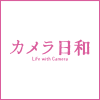[Question 4] What should I do if the background bokeh effect is not what I expected?
So you're having trouble creating an impressive background bokeh effect......To address such concerns, let's learn some techniques that will help create a larger bokeh effect. There are several ways to do so but in this example, we will be learning about some typical points that are easy to perform. (Edited by Camera Biyori, Photos by: Yuji Ogura)

Pages: 1 2
Camera Settings

Av: Aperture-Priority AE, M: Manual
A1: Open up the lens aperture

The smaller the lens aperture value, the greater the bokeh effect in the foreground and background of the subject in focus, resulting in a soft image. The smallest f-number is known as the “maximum aperture” and varies for each lens.
What is aperture?
Aperture refers to the size of the lens opening, which regulates the amount of light that reaches the image sensor. The aperture value is a numerical representation of the size of the opening.

Notation of the maximum aperture of the lens
A2: Get as close to the subject as possible

The bokeh effect increases the closer you are to the subject. The shortest distance required for the subject to be in focus is known as the “minimum shooting distance” and varies for each lens.
What is minimum shooting distance?
The number indicated on the lens is the minimum shooting distance (as shown in the red circle in the photo). The minimum shooting distance is measured from the “Focal plane mark” found at the top of the camera body to the subject.

Notation of minimum shooting distance on the lens

Image plane symbol on the camera body

Photo with the focus on the deer in the foreground. If the f-number is increased, both the deer in the background and the details of the poster are clearly captured.

Photo with the focus on the same deer in the foreground. However, by reducing the f-number, both the poster and deer in the background are out of focus, thus making the main subject stand out.
Shot with F4 and at a distance of 25 cm from the subject

Shot at a minimum shooting distance of 25 cm. The focus position is on the top button. The bokeh effect increases the further you move away from the focus position.
Lenses that let you have fun with the bokeh effect
Prime lens


Unlike a zoom lens, the angle of view cannot be changed for a prime lens. However, as these lenses have a simple structure, there are many bright lenses with a small maximum aperture available. Generally, a good bright lens is one with a maximum aperture of 2.8 or below.
Macro lens


These lenses have a close-up performance superior to that of normal lenses and are convenient for shooting subjects up close. Another feature is the ease in creating bokeh effects.
Take up the photography challenge!
A soft image is created when there is a large bokeh effect!
Shot with a prime lens

Using EF-S24mm f/2.8 STM
Shot with f/2.8
Shot with a macro lens

Using a EF-S60mm f/2.8 macro USM
Shot with f/2.8

Using a EF-S60mm f/2.8 macro USM
Shot with f/2.8

Ogura's work in photography expands from shooting photographic works to development and printing films. He is one of the tutors at the "Camera Biyori Photography School". He started his career as an engineer at a film laboratory and later establishes his own "mogu camera" lab. He also runs the "mogu sun" portrait studio.

Camera Biyori is a Japanese photography magazine introducing charming photos and daily joy with cameras. Suggesting fun activities relating to cameras and photography, Camera Biyori editorial department also offer the "Camera Biyori Photography School" to recommend its readers to engage in photography and have fun.
Published by Daiichi Progress Inc.
































